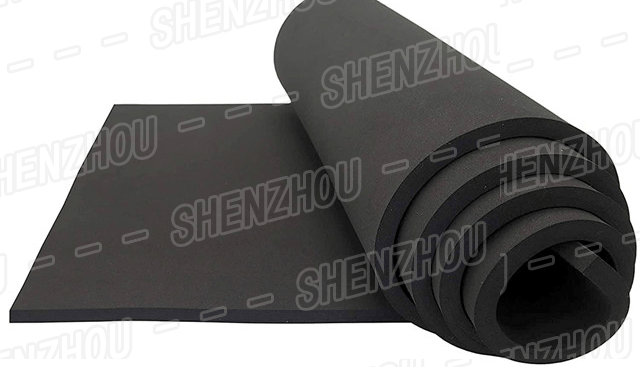
Closed Cell Foam:4 Compelling Reasons to Choose It
1/9/20246 min read


Closed Cell Foam

WHAT IS CLOSED CELL FOAM? CLOSED CELL FOAM ROLL?
Closed cell foam
Closed cell foam is a unique type of foam distinguished by its enclosed cell structure where gas molecules are encapsulated and lack interconnection. The measurement metrics for foams typically include density, indicating the foam's stiffness, and compression set resistance, which gauges how quickly the foam can rebound after compression.
This particular cellular arrangement contributes to the creation of a textile that surpasses the stability and durability of open cell foams, where gas molecules are interconnected. One noteworthy feature of closed cell foams is their impermeability to water and resistance to sweat. Furthermore, owing to their structural composition, they are often amenable to perforation and can be easily shaped into foam rolls for subsequent lamination processes.

Categories
Popular
10 COMMON TYPES OF CLOSED CELL FOAMS:
Polyethylene (PE) Foam:
Characteristics: Lightweight, flexible, good insulation properties, resistant to chemicals.
Applications: Packaging, insulation, flotation devices.
Polyurethane (PU) Foam:
Characteristics: Durable, versatile, good thermal insulation, available in various densities.
Applications: Cushioning in furniture, automotive interiors, insulation.
Polystyrene (PS) Foam:
Characteristics: Lightweight, rigid, good thermal insulation.
Applications: Packaging, construction insulation, disposable food containers.
EVA Foam (Ethylene Vinyl Acetate):
Characteristics: Soft, flexible, excellent shock absorption, water-resistant.
Applications: Sports equipment, shoe insoles, mats.
Neoprene Foam:
Characteristics: Excellent weather resistance, water-resistant, buoyant.
Applications: Wetsuits, gaskets, marine applications.
EPDM Foam (Ethylene Propylene Diene Monomer):
Characteristics: UV resistant, weatherproof, good insulation.
Applications: Automotive seals, weather stripping, outdoor gaskets.
NBR Foam (Nitrile Butadiene Rubber):
Characteristics: Oil-resistant, durable, good insulation.
Applications: Seals, gaskets, insulation in oil and gas industries.
PVC Foam (Polyvinyl Chloride):
Characteristics: Lightweight, rigid, good chemical resistance.
Applications: Signage, construction, marine applications.
Silicone Foam:
Characteristics: High-temperature resistance, flame retardant, flexible.
Applications: Aerospace, electronics, high-temperature gaskets.
Cross-Linked Polyethylene (XLPE) Foam:
Characteristics: Closed-cell structure, good chemical resistance, lightweight.
Applications: Packaging, insulation, automotive components.
Closed cell foam roll
Conventional closed cell foam rolls often exhibit a notable stiffness, lacking the softness and flexibility commonly found in open cell foams. Nevertheless, innovative materials like NBR and the revolutionary SHENZHOU CLASS® have successfully overcome these constraints, imparting flexibility to closed cell foams. It's worth noting that traditional closed cell foams typically offer a more limited color range compared to their open cell counterparts.
Due to distinct physical properties, each foam type comes with its own set of performance limitations. Traditionally, open cell foams found applications primarily in specific areas such as shoe uppers, while closed cell foams were reserved for places like the midsole. This dichotomy has contributed to increased manufacturing costs for end products.


APPLICATION FOR CLOSED CELL FOAM
Insulation:
Closed-cell foam is widely used for thermal insulation in buildings, walls, roofs, and HVAC systems. Its low thermal conductivity helps maintain temperature control and energy efficiency.
Packaging:
The cushioning and shock-absorbing properties of closed-cell foam make it ideal for protective packaging of fragile and sensitive items. It provides excellent impact resistance during transportation.
Automotive:
Closed-cell foam is utilized in automotive applications for its sound dampening, vibration isolation, and thermal insulation properties. It is commonly found in door panels, headliners, and seating components.
Marine:
Closed-cell foams, especially those resistant to water and chemicals, are used in marine applications. They provide buoyancy in flotation devices, boat cushions, and other marine components.
Sporting Goods:
In the sports industry, closed-cell foam is used for padding and shock absorption in equipment such as helmets, knee pads, yoga mats, and exercise mats......
Learn more about the Closed Cell Foam
SHENZHOU® CLOSED CELL FOAM
The main difference between open-cell and closed-cell foam lies in their cellular structures. Open-cell foam has interconnected cells, allowing air and gases to move freely. In contrast, closed-cell foam has sealed cells, creating a more impermeable structure. Open-cell foam is softer and more flexible but permeable, while closed-cell foam is rigid, less flexible, and impermeable. The choice depends on specific application needs.
WHAT IS THE DIFFERENCE BETWEEN OPEN CELL AND CLOSED CELL FOAM?
Shenzhou® Closed Fell Foam insulation products specially import foreign new technology and process. Excellent performance NBR is used as the main raw material, environmental protection foaming agent is used, and the unique "vacuum microcrystalline foaming technique" (vmft) of Shenzhou is used to precisely control micro foaming. The vesicles were dense and the rate of closure was high.
It is a high flame retardant, effectively prevent condensation, improve energy efficiency, mildew proof, safety and environmental protection high performance products.The whole process of products from raw materials entering the factory, manufacturing, leaving the factory and after-sales tracking is monitored by AAAA quality supervision and control system to ensure the excellent quality of products.
DESIGN AND MANUFACTURING ADVANTAGES OF SHENZHOU® CLOSED CELL FOAM:
Non-Toxic and Fiber Dust-Free:
Shenzhou® closed-cell foam insulation products are devoid of fiber dust and do not emit toxic or harmful substances, ensuring a safe environment.
Temperature Range Suitability:
Suitable for heat insulation in various pipelines and equipment, the products accommodate a medium temperature range from -40 °C to 105 °C, offering versatility in applications.
Compliance with Standards:
The materials used in Shenzhou® products adhere to national standard GB 8624, meeting both Class B1 requirements in 2012 and Class 0 requirements of bs476 part6:1997, ensuring high-quality standards.
Agion Nano Silver Antibacterial Technology:
The incorporation of the "Agion Nano Silver Antibacterial" technical formula in the Class0 high-end rubber foam insulation products enables continuous release of nano silver ions. This technology effectively eliminates bacteria, mold, and fungi on surfaces, contributing to heat insulation and energy savings.
Implantable Antibacterial and Antimycotic Technology:
The Agion nano silver antibacterial factor is implanted into the molecular structure of the material, providing lifelong antibacterial and antimycotic effects. Even if the product surface is damaged, these effects remain intact, eliminating the need for regular maintenance and cleaning.
Safety and Harmlessness:
Shenzhou® closed-cell foam products, with Agion technology, are safe and harmless to the human body. The antibacterial and mildew-proof effects persist, ensuring long-term safety without the need for frequent maintenance.
Energy-Efficient Insulation:
The products not only prioritize safety but also contribute to energy efficiency by effectively insulating heat. This makes them an environmentally friendly choice, providing customers with safer and healthier alternatives.
Due to the exclusive manufacturing process employed by SHENZHOU®, closed-cell foam rolls can be intricately cut into exceptionally thin and precise sheets, tailored to specific requirements for laser cutting, embossing, or thermo-molding. Subsequently, these sheets can be integrated with one or more layers utilizing a patented and eco-friendly lamination technique, and then undergo processing for final packaging. SHENZHOU® stands out as the pioneering solution for designers, manufacturers, and supply chain managers alike, presenting a closed-cell foam product that not only ensures greater consistency but also minimizes energy consumption, enhances production efficiency, adheres to eco-friendly practices, and is fully customizable to meet unique needs.
FREQUENTLY ASKED QUESTIONS ABOUT CLOSED CELL FOAM
Q1:How does closed cell foam compare to other types of foam?
Closed-cell foam differs from other types of foam, like open-cell foam, in its sealed cell structure, providing impermeability. It is denser, rigid, and offers better water resistance, making it suitable for insulation and buoyancy applications. Closed-cell foam tends to have superior thermal insulation properties compared to open-cell foam, but it is generally more expensive. The choice depends on specific needs, with closed-cell foam excelling in scenarios requiring water resistance, buoyancy, and precise customization.
Q2:Is Closed Cell Foam waterproof ?
The sealed cell structure of closed-cell foam makes it impermeable to water, providing excellent water resistance. This property makes closed-cell foam suitable for various applications where protection against moisture is essential, such as in insulation, marine applications, and water-resistant packaging.
















About Us
Click the button below to get more information about us
Newsletter
Click to subscribe for more information
Follow Us
Contact Us
Address
Dacheng town, Langfang City, Hebei province, China
Phone
+86 185 03165 626
